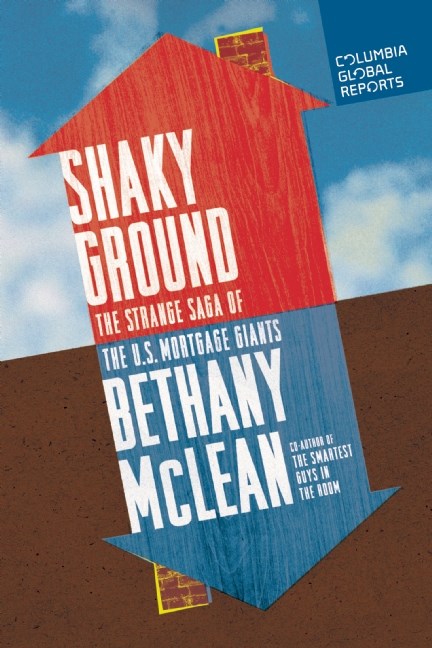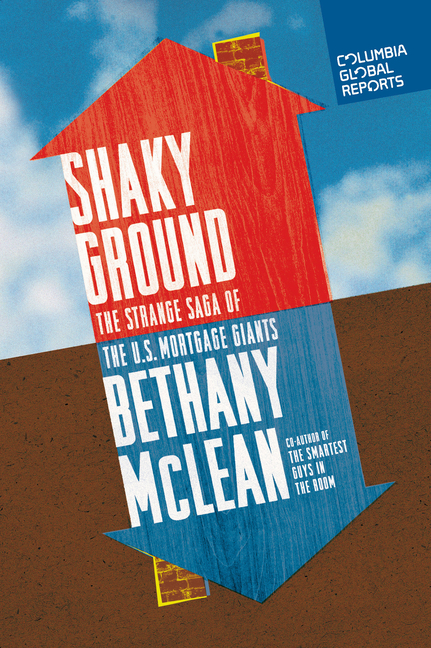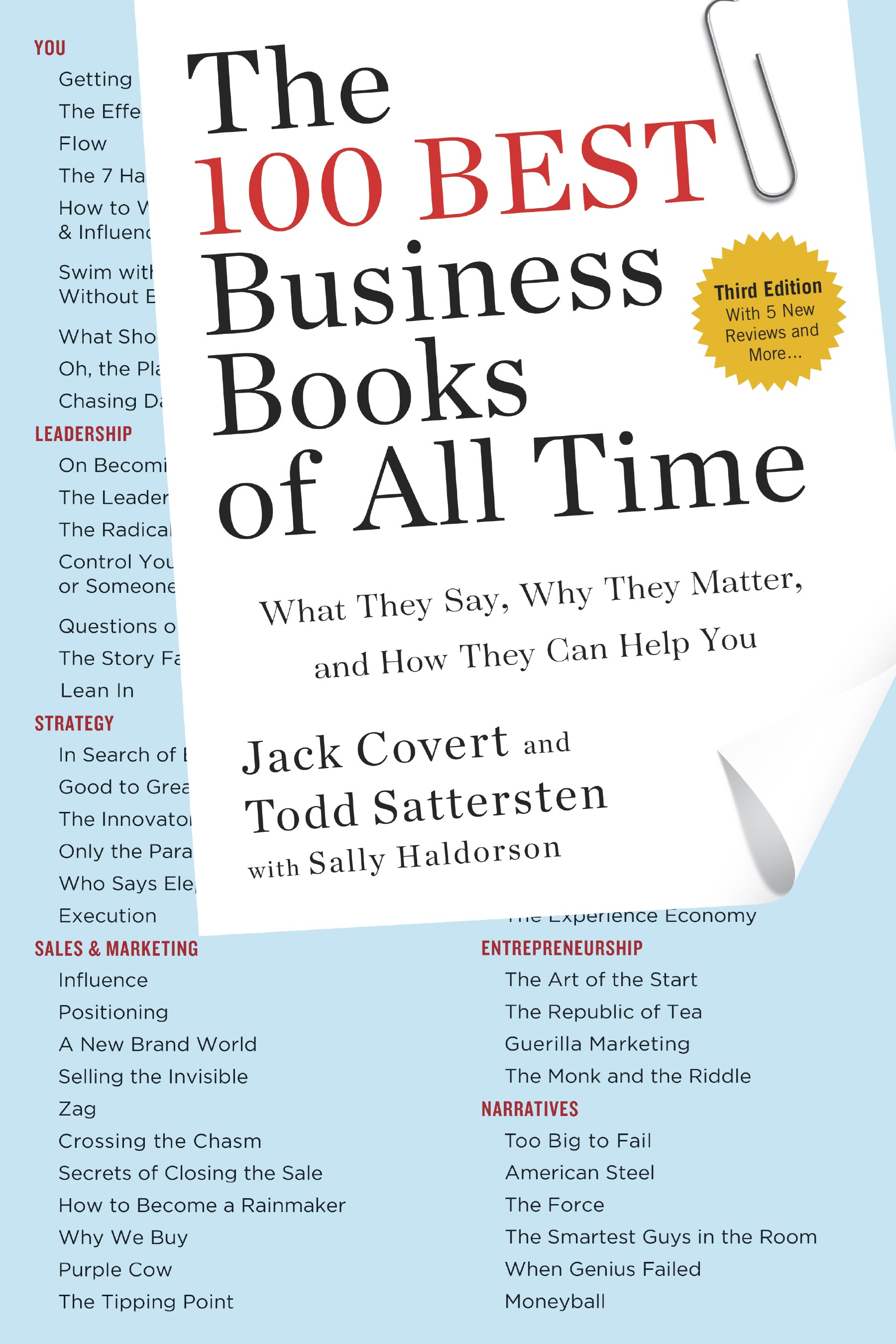Shaky Ground: The Strange Saga of the U.S. Mortgage Giants
September 17, 2015
Bethany McLean weaves a tale of Fannie Mae and Freddie Mac that enlightens, enrages, and educates.

Shaky Ground: The Strange Saga of the U.S. Mortgage Giants by Bethany McLean, Columbia Global Reports, 159 pages, $12.99, Paperback, September 2015, ISBN 9780990976301
Home ownership has long been a pillar of the American Dream. Bethany McLean argues that, in this day and age, it probably should not be, but that doesn’t change the story she’s about to tell.
If you don’t know who Bethany McLean is, you should remedy that. She is the co-author, with Peter Elkind, of The Smartest Guys in the Room, a book that documented the rise and fall of Enron and which Jack Covert, the man this column takes its name from, named as one of The 100 Best Business Books of All Time. She also coauthored one of the best books written on the financial crisis, with Joe Nocera, in All the Devils Are Here. Now, she is back with a book of her own that has yet another scandalous tale to tell. And the kicker here is that the saga is ongoing, largely ignored, and probably affects you personally.
The story of Shaky Ground hinges on a lawsuit (or, rather, about 20 of them) filed by hedge-fund managers against the United States government. These hedge-funds all own stock in Fannie Mae and/or Freddie Mac, and they would like to see these two Government Supported Enterprises (GSEs) returned to a “safe and sound condition” so that they can capitalize on their investments.
This is where things get slightly complicated. Fannie and Freddie are still publicly traded companies, but they were put into conservatorship during the financial crisis. In fact, McLean argues that while most people put the start date of the global financial crisis at September 15, 2008 when Lehman Brothers declared bankruptcy, it more rightly belongs 9 days earlier when the U.S. Treasury put Fannie and Freddie into conservatorship (extending a $200 billion line of credit to guarantee loans), where it remains until this day with no end in sight. But, though the government owns 79.9 percent of the company, 20.1 percent of their shares were left in private hands. Some savvy investors bought up those shares as their stock price hovered around zero, but they are not being paid dividends on their investments because the (now very substantial) profits Fannie and Freddie make today are been used to reduce the federal deficit—per new, “Third Amendment” terms of their bailout established in 2012.
But lets back up and explain how these Government Supported Enterprises (GSEs) got to conservatorship in the first place and why it remains there. That is a sad and sometimes funny tale. "The GSE world," as one long-time lobbyist told her, “is a cross between Monty Python and Shakespeare.” It started as Wall Street began aggressively entering the subprime mortgage market, and Fannie and Freddie felt compelled to join the fray to maintain its market share. This is a story that’s been told very well many times, including in All the Devils Are Here. But there’s a brief description in Shaky Ground of conscious decision made by Fannie Mae in 2005 that sums it up perfectly:
In a presentation for a 2005 executive retreat, Tom Lund, who was then the head of Fannie’s single-family business, put it this way: “We face two stark choices: stay the course [or] meet the market where it is.” According to an interview with staff of the Financial Crisis Inquiry Comission, Lund went on to say that if Fannie May stayed the course, it would maintain its credit discipline, protect the quality of its book, preserve capital, and be able to speak publicly about its concerns over the declining quality of mortgages. However, he said, Fannie would also face lower volumes and revenues, continued decline in market share, lower earnings, and a weakening of key customer relationships.
So they made their choice, with disastrous consequences. And while other financial institutions have largely recovered, and now must abide by government regulations that force them to hold more capital, Fannie and Freddie keep no cash reserves, because the federal government is taking “practically every penny of profit that the two companies generate to shrink the federal deficit.” In essence, all the rules they are now enforcing on private institutions, they are forcing the GSEs to break so that the mortgage market won’t completely collapse and they can use the profits to pay down some of the debt.
McLean extends the narrative to give us a history of how the government’s involvement in the mortgage market even began, and that takes the story to the Great Depression, and the “Federal National Mortgage Association, or FNMA—or Fannie Mae,” set up to buy loans the government had guaranteed in an attempt to get privately owned mortgage associations to do the same. None ever did, leaving the government to do the work on its own and leading to the unusual system the U.S. has today. (As the former governor of the Bank of England, Mervyn King, told Mclean: “Most countries have socialized health care and have a free market for mortgages. You in the United States do exactly the opposite.") Fannie Mae remained a government owned organization until 1968, when the Johnson administration privatized it to keep its from being added to the national deficit. We then head through the savings and loan days, and their push for a competitor to Fannie Mae they could sell loans to, which prompted congress to create the Federal Home Loan Mortgage Corporation—Freddie Mac. The collapse of the savings and loans companies, and the rise of Wall Street securitization and “private label” securities are explained in some detail, as is how the GSEs, before the collapse, had become a part of a “housing industrial complex” that kept (and largely still keeps) construction booming, banks loaning, and people buying. Fannie became the centerpiece in that complex, with political muscle across the country and a revolving door to congress and other political institutions. Until the financial crisis and resulting conservatorship, that is, when a condition of their bailout forced them to fire all their lobbyists.
And back to the modern day now, McLean handily dispels the myth that government policy in the way of affordable housing goals, and Fannie and Freddie’s need to meet them, primarily caused the crisis—as a popular narrative at the time contended.
The majority of risky mortgages were not made to put people in homes. Rather, they were cash-out refinancings and purchases of investment properties. … A study published by the National Bureau of Economic Research in early 2014 says that the wealthiest 40 percent of borrowers got 55 percent of the new loans in 2006—the peak year of the bubble—and over the next three years, the were responsible for nearly 60 percent of delinquencies.
But that didn’t stop the agencies from becoming public pariahs, hated by all sides. And because all sides were so long calling for their abolishment, they have largely been gutted. McLean calls them “zombie agencies”—not quite dead, but not really alive, either.
They have managed a worst-of-both-worlds status: too political to be financially secure, but too financially insecure to accomplish their political mission.
And though there was then a time when it seemed no one would say a nice thing about “the toxic twins,” and everyone was tripping over each other to be the most vociferous supporters of abolishing them, a bill to do so never reached the Senate floor and we now have a kind of limbo in which the GSEs still exist to grease the wheels of the mortgage industry and their profits pay off the national debt. Democrats see a mission still to be fulfilled, and Republicans want to starve the agencies of any cash, so their profits are still being sucked away to pay down the debt. And, oh yeah, that lawsuit—it’s likely to go nowhere.
This is where, after all her copious reporting, McLean offers a glimpse of her own thoughts on the American Dream and the reasons we should have started from scratch when we could. But even she ultimately concludes that “If we cannot move away from the cult of homeownership right now, then let’s fix what we have.” She describes many ways we can potentially do that, including a suggestion by former Fannie CEO Franklin Raines to have "Fannie and Freddie become cooperatives that are owned by homeowners, much as big insurance cooperatives like State Farm are owned by policyholders." To me, that seems to align the American Dream of home ownership with our ongoing experiment in self-government more than the limbo it currently exists in or the quasi-public state it was in before. This touches us at home and at work, and it's not just an American problem because the debt has been bought up by investors around the world, so it affects us geopolitically as well. So, regardless of what it looks like or who inherits the problem in the 2016 election, we all share a stake in the outcome.




